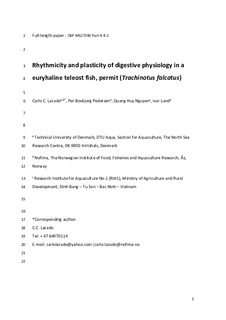| dc.contributor.author | Lazado, Carlo C. | |
| dc.contributor.author | Pedersen, Per Bovbjerg | |
| dc.contributor.author | Nguyen, Quang Huy | |
| dc.contributor.author | Lund, Ivar | |
| dc.date.accessioned | 2018-01-26T14:15:14Z | |
| dc.date.available | 2018-01-26T14:15:14Z | |
| dc.date.created | 2017-07-29T08:33:45Z | |
| dc.date.issued | 2017 | |
| dc.identifier.citation | Comparative Biochemistry and Physiology A. 2017, 212 107-116. | nb_NO |
| dc.identifier.issn | 1095-6433 | |
| dc.identifier.uri | http://hdl.handle.net/11250/2479975 | |
| dc.description.abstract | Digestive physiology is considered to be under circadian control, but there is little evidence in teleost fish. The present study explored the rhythmicity and plasticity to feeding schedules of enzymatic digestion in a candidate aquaculture fish, the permit (Trachinotus falcatus). The first experiment identified the rhythms of digestive factors throughout the light-dark (LD) cycle. Gastric luminal pH and pepsin activity showed significant daily variation albeit not rhythmic. These dynamic changes were likewise observed in several digestive enzymes, in which the activities of intestinal protease, chymotrypsin and lipase exhibited significant daily rhythms. In the second experiment, the existence of feed anticipatory activity in the digestive factors was investigated by subjecting the fish to either periodic or random feeding. Anticipatory gastric acidification prior to feeding was identified in periodically fed fish. However, pepsin activity did not exhibit such anticipation but a substantial postprandial increase was observed. Intestinal protease, leucine aminopeptidase and lipase anticipated periodic mealtime with elevated enzymatic activities. Plasma melatonin and cortisol demonstrated robust daily rhythms but feeding time manipulations revealed no significant impact. Plasma ghrelin level remained constant during the LD cycle and appeared to be unaffected by differing feeding regimes as well. Taken together, the digestive factors of permit were highly dynamic during the LD cycle. Periodic feeding entrained digestive physiology and mediated anticipatory gastric acidification and intestinal enzymatic activities. This knowledge will be essential in developing feeding protocols and husbandry-related welfare strategies that will further advance this candidate finfish as an aquaculture species. | nb_NO |
| dc.language.iso | eng | nb_NO |
| dc.title | Rhythmicity and plasticity of digestive physiology in a euryhaline teleost fish, permit (Trachinotus falcatus) | nb_NO |
| dc.type | Journal article | nb_NO |
| dc.type | Peer reviewed | nb_NO |
| dc.description.version | acceptedVersion | nb_NO |
| dc.source.pagenumber | 107-116 | nb_NO |
| dc.source.volume | 212 | nb_NO |
| dc.source.journal | Comparative Biochemistry and Physiology A | nb_NO |
| dc.identifier.doi | 10.1016/j.cbpa.2017.07.016 | |
| dc.identifier.cristin | 1483320 | |
| cristin.unitcode | 7543,1,4,0 | |
| cristin.unitname | Fiskehelse | |
| cristin.ispublished | true | |
| cristin.fulltext | postprint | |
| cristin.qualitycode | 1 | |
